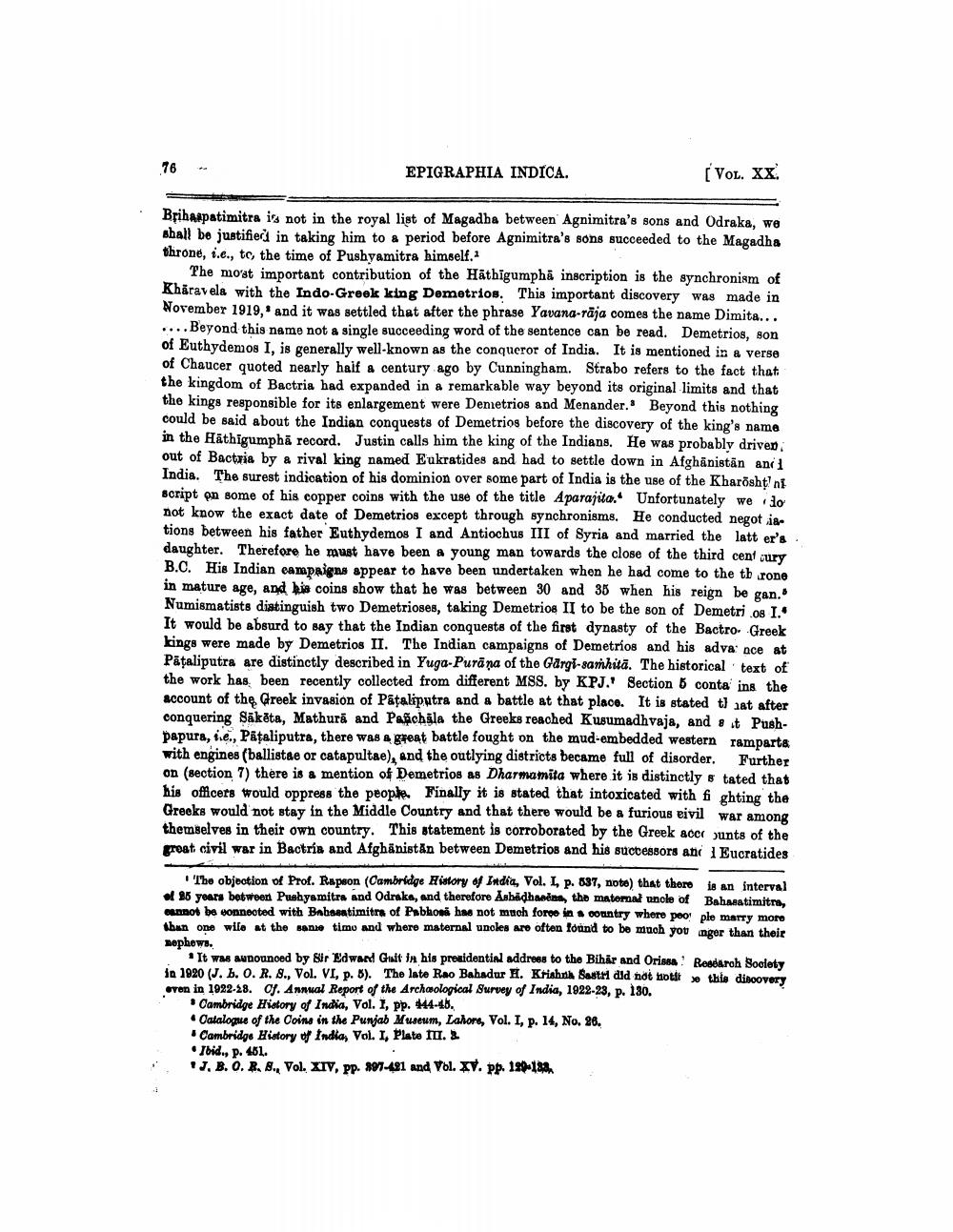________________
EPIGRAPHIA INDICA.
[Vol. XX
Bțihaspatimitra is not in the royal list of Magadha between Agnimitra's sons and Odraka, we shall be justified in taking him to a period before Agnimitra's sons succeeded to the Magadha throne, i.e., to the time of Pushyamitra himself.
The most important contribution of the Hāthīgumpha inscription is the synchronism of Khāravela with the Indo-Greek king Demetrios. This important discovery was made in November 1919, and it was settled that after the phrase Yavana-rāja comes the name Dimita... ....Beyond this name not a single succeeding word of the sentence can be read. Demetrios, son of Euthydemos I, is generally well-known as the conqueror of India. It is mentioned in a verse of Chaucer quoted nearly half a century ago by Cunningham. Strabo refers to the fact that the kingdom of Bactria had expanded in a remarkable way beyond its original limits and that the kings responsible for its enlargement were Demetrios and Menander. Beyond this nothing could be said about the Indian conquests of Demetrios before the discovery of the king's name in the Häthigumphā record. Justin calls him the king of the Indians. He was probably driven out of Bactria by a rival king named Eukratides and had to settle down in Afghánistān anii India. The surest indication of his dominion over some part of India is the use of the Kharoshtni script on some of his copper coins with the use of the title Aparajita. Unfortunately we do not know the exact date of Demetrios except through synchronisms. He conducted negotia tions between his father Euthydemos I and Antiochus III of Syria and married the latter's daughter. Therefore he must have been a young man towards the close of the third cent cury B.C. His Indian campaigns appear to have been undertaken when he had come to the throne in mature age, and his coins show that he was between 30 and 35 when his reign be gan. Numismatists distinguish two Demetrioses, taking Demetrios II to be the son of Demetrios 1. It would be absurd to say that the Indian conquests of the first dynasty of the Bactro Greek kings were made by Demetrios II. The Indian campaigns of Demetrios and his advance at Pătaliputra are distinctly described in Yuga-Purāņa of the Gargi-samhita. The historical text of the work has been recently collected from different MSS. by KPJ.' Section 5 contains the account of the Greek invasion of Pataliputra and a battle at that place. It is stated t) at after conquering Säkēta, Mathurā and Panchala the Greeks reached Kusumadhvaja, and 8 t Pushpapura, hie., Pataliputra, there was a great battle fought on the mud-embedded western ramparte with engines (ballistae or catapultae), and the outlying districts became full of disorder. Further on (section 7) there is a mention of Demetrios as Dharmamita where it is distinctly s tated that his officers would oppress the people. Finally it is stated that intoxicated with fighting the Greeks would not stay in the Middle Country and that there would be a furious eivil war among themselves in their own country. This statement is corroborated by the Greek acer junts of the roat civil war in Bactria and Afghanistán between Demetrios and his successors ani 1 Eucratides
The objetion of Prof. Raphon (Cambridge History of India, Vol. L p. 637, note that there is an interval of 25 years between Pushyamitra and Odrake, and therefore Asbadharins, the matemal uncle of Bahmatimitra, annot be wonnected with Bnbaantimitra of Pablonk has not much foroo in oonntry where people marty more than one wilo at the sense time and where maternal uncles are often found to be much younger than their nephews.
It was announced by Sir Edward Guit in his presidential address to the Bihar and Orissa! Realaroh Society in 1920 (J. b. O. R. 8., Vol. VI, p. 8). The late Rao Bahadur H. Krishna Sast did not hot so this discovery even in 1922-28. Cf. Annual Report of the Archaological Survey of India, 1922-28, p. 130.
. Cambridge History of India, Vol. 1, pp. 44-45.
Catalogue of the Coins in the Punjab Museum, Lahore, Vol. I, p. 14, No. 26. . Cambridge History of India, Vol. I, Plato III. &
Ibid., p. 451. "J, B. O. R. 8., Vol. XIV, PP. 897-491 and Vol. XV. pp. 140-180




